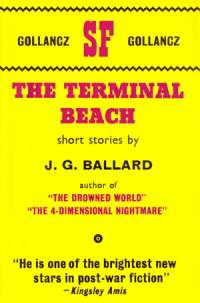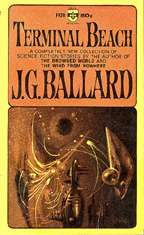The Terminal Beach
The Terminal Beach is a collection of science fiction short stories by British author J. G. Ballard, published in 1964.
 Cover of the first edition. | |
| Author | J. G. Ballard |
|---|---|
| Country | United Kingdom |
| Language | English |
| Genre | Science fiction |
| Publisher | Victor Gollancz Ltd |
Publication date | 1964 |
| Media type | Print (hardback) |
| Pages | 221 pp |
| ISBN | 1-85799-021-8 |
| OCLC | 31816321 |
| LC Class | PR6052.A46 T47 1993 |
Contents
British edition
- "The Terminal Beach": A man who does not come to terms with the premature death of his wife and son steals away onto an island of Eniwetok, once used for testing nuclear weapons. Between the decaying buildings on the island, the reader follows his mental and physical decline.
- "A Question of Re-entry": This story has some parallels to Joseph Conrad's Heart of Darkness, with the protagonist traveling upriver in the Amazon rain forest, to meet a European who went native. The story evolves around the clash between civilization-based knowledge and native belief.
- "The Drowned Giant": A giant human(oid) body washes ashore. The initial wonder soon gives way to banality as people start to climb over the body and remove or vandalize parts of it until the body is completely dismembered. It is then widely believed that the giant never existed at all.
- "End-Game": A psychological match between a person on death row, who lives with his executioner in a comfortable house, and does not know the time and day of his execution. To pass the time, they are playing chess and at the same time the death candidate tries to win a game of persuasion.
- "The Illuminated Man": A precursor to the novel The Crystal World.
- "The Reptile Enclosure": Infrared lights from a newly launched radio satellite trigger thousands of people on the beach to drown themselves.
- "The Delta at Sunset"
- "Deep End"
- "The Volcano Dances"
- "Billennium"
- "The Gioconda of the Twilight Noon"
- "The Lost Leonardo": A painting by Leonardo da Vinci of the Crucifixion of Jesus is stolen from the Louvre Museum. Two art directors, seeking the thief, examine several crucifixion paintings, each also previously stolen, and discern a hitherto-unnoticed man in each one. Not only is the face recognizably the same in each, no matter which artist, country, or century, the portraits of this man are also alterations of the original paintings. They determine he is the Wandering Jew, and also the thief and forger.
US edition

US edition, Berkley Books, 1964.
- "End-Game"
- "The Subliminal Man"
- "The Last Word of Mr. Goddard"
- "The Time Bombs"
- "Now Wakes the Sea"
- "The Venus Hunters"
- "Minus One"
- "The Sudden Afternoon"
- "The Terminal Beach"
In popular culture
- A copy of the 1987 edition is briefly seen being read by a security guard played by Ken Jeong in the 2019 superhero film Avengers: Endgame, which shares its subtitle with a story in the book.
gollark: No, mine is.
gollark: I was more putting that in ironically due to the `split_off`, which does allocation, in the loop.
gollark: Funnily enough, LyricLy's issues with the``` // We're using a streaming algorithm to compile it, for high performance // This means we need to define some buffers to fill with data beforehand // This is an important loop, so we make sure to avoid allocations during it // by predefining them here```bit were not ones I actually realized.
gollark: Nonsense, our RNG API™ is utterly secured.
gollark: Also the blatant lies about all aspects of the code.
References
- Tuck, Donald H. (1974). The Encyclopedia of Science Fiction and Fantasy. Chicago: Advent. p. 28. ISBN 0-911682-20-1.
This article is issued from Wikipedia. The text is licensed under Creative Commons - Attribution - Sharealike. Additional terms may apply for the media files.